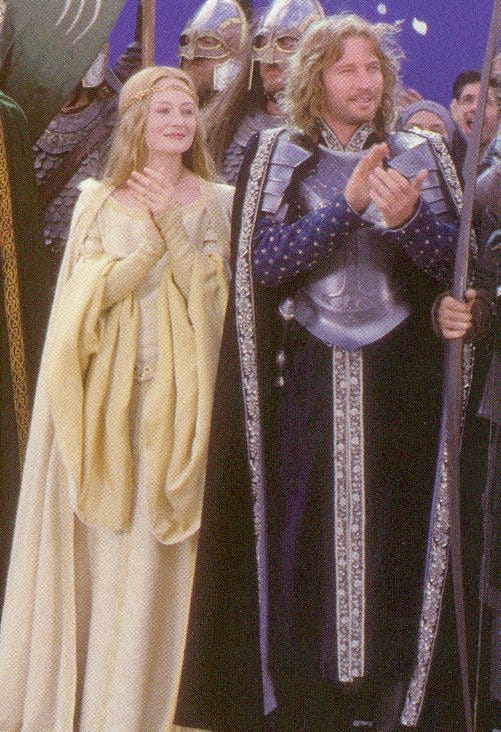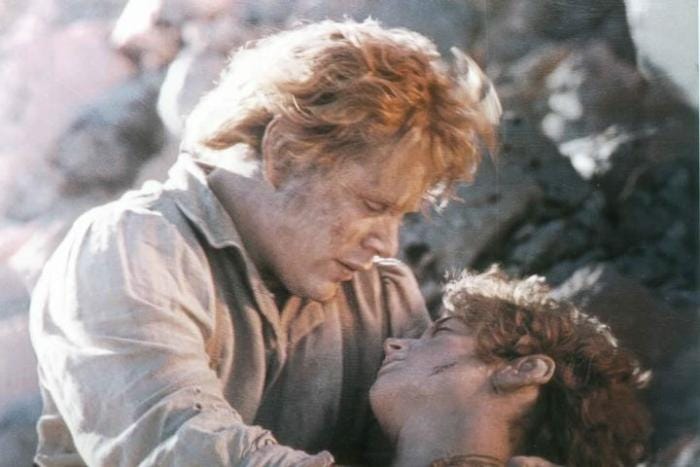Love in War
2004 Hobbits and Heroes
This is the penultimate lecturette from my 2004 online course called Hobbits and Heroes, over at DU’s professional writing program. If you’ve been following me the past few weeks, you’ll remember that these are lecturettes from that old class meant to spark discussion on our discussion boards, and ignite ideas for the week’s assignments. This week, we had read through all of the Hobbit and Lord of the Rings trilogy. Also remember, the Jackson blockbusters were still fresh and new, and his Hobbit films hadn’t been made yet. Feel free to respond to any prompts or questions in the comments here, in lieu of a discussion board. I mean, they work the same way, don’t they?
“I would not see a thing that is high and excellent cast away needlessly.”
“Nor would I…therefore I say to you, lady: Stay! For you have no errand to the South.”
“Neither have those others who go with thee. They go only because they would not be parted from thee—because they love thee.”
The cliché “love makes the world go ‘round” is absolutely true in LOTR. More than being mythologically posing representatives, the “good-guys” in the epic act out of passion and love, which is inevitably how they win the War of the Ring. Friends, servants, and lovers stick together through the intensely harsh circumstances in the last book, and the many love-ties are the foundations for victory and the basis for the New Age of Middle-earth.
Romantic Love
Aragorn, Arwen, and Eowyn
Though we get to know Aragorn pretty well since his appearance as Strider way back in Bree, we barely see Arwen at all until their love story appears in the Appendices. She is physically described in detail, her beauty (and alleged wisdom) a beacon to Aragorn through all he endures. Arwen’s presence is almost purely in his mind, particularly before he takes off to the Paths of the Dead: mainly because he may never exit said place of terror, but also because he has to let Eowyn down gently before he does so. Arwen’s Galadriel-like bestowing of gifts at the end of the epic make her even more what she really is throughout: a prize that Aragorn (and everybody, since she is now Queen) wins by his victory. Even earlier in Lothlorien, when Galadriel discusses what Aragorn’s gift is to be: he (and she) speak of Arwen. She, indeed, is the gift that Galadriel (and Elrond) give, to be collected as long as Aragorn survives to be King.
Of course we are told that Eowyn is in love with Aragorn (some of us wish he’d end up with her instead of Arwen, but oh well), and it is just before Aragorn leaves for the Paths of the Dead that he actually turns her down, much to everyone’s chagrin:
“Few other griefs amid the ill chances of this world have more bitterness and shame for a man’s heart than to behold the love of a lady so fair and brave that cannot be returned.”
In Return of the King, it is made plain that Eowyn loves Aragorn because of his title and valor—more of a love of his glory than a true personal love. When in the House of Healing in Gondor, she meets and chills out with Faramir, who awakes in her warmth and real love. Remember, everyone describes Eowyn throughout as the “cold maiden of the Rohirrim,” or something similar, always describing her as cold, frosty, aloof. When Faramir confesses his love, however, she is transformed:
Then the heart of Eowyn changed, or else at last she understood it. And suddenly her winter passed, and the sun shone on her.
Aw. Talk about warm and fuzzy.
Friendship
Legolas and Gimli
Two peoples, both alike in dignity, when put into an adventure, learn love and understanding for one another. Gimli’s transformation happens in Lorien, when the love of the Lady Galadriel moves him to most un-Dwarf-like behavior. Legolas and Gimli later have a friendly contest of how many orc-heads each has hewed, which is so endearing it’s some of the best (and necessary) bits of comic relief we get in the series of epic battles in RotK. They both make each other a promise: that if both survive and Sauron is indeed destroyed, then Gimli will show Legolas through the great caves behind Helm’s Deep, and Legolas will in turn lead Gimli through Fangorn. They are both still of their own kind, yet when confronted with the unknown, each is a comfort to the other. We also find out in the Appendices that Gimli eventually follows Legolas into the eternal Elfhome lands. Like Pippin and Merry in Elrond’s Council, or Sam trailing Frodo, Gimli and Legolas are so attached that Legolas won’t go into eternity without Gimli at his side.
Frodo and Sam
I have been calling Sam Frodo’s “caddy” through the past couple of weeks. It is from this loyal gentleman/servant relationship that the love between Frodo and Sam develops. A combination of the Victorian era’s ideal of “romantic friendship” and the relationship between an officer and attendant in early war shows these two with arguably the strongest love-bond in the story. Contemporary readers (and film-watchers) have been mystified by this relationship, as Sam continues to call Frodo “master” and “sir” yet the physical tenderness between them (lying with head in lap, holding hands, even a chaste forehead-kiss) adds up to apparent homosexuality. But what too many contemporary people forget (especially Americans with our hyper-sexual paranoia when it comes to morality) is that there is such a thing as deep and intimate love without sexuality involved.*
Back in the day, when men went to school and women didn’t (or they went to different schools), the close friendships men made in “high school” and at University would be of one’s own gender, almost exclusively. Holmes and Watson are another famous pair of this “romantic friendship” ideal, also misunderstood by modern folks. But marriage, even as late as the turn of the last century (and even later, let’s be honest), was purely an economical arrangement, not having much to do with mutual partnership and love. Women were not really a part of society in earlier eras on which LOTR is based, even up till Tolkien’s day (witness our discussion of women in the series as per our Eowyn Heroine lecturette), and so close bonds between young educated people of mutual interests would nearly always be same-gendered. When these men would decide to marry, they were lucky to find a woman who they would want to marry, who they also loved. You go, Faramir!
*MODERN AUTHOR NOTE: Am I against homosexuality, or against reading these characters as such? Of course not (I’m LGBTQ myself, I would never)! I just think that slapping a modern gay label on these characters is a shallow interpretation of what these relationships mean, and what their depth does to propel the story along. Whether or not they’re doing the horizontal hustle “off-camera” has nothing to do with their love for each other, or the actions they take on each other’s behalf. Go write your slashy erotic fanfic if you want, that’s awesome, and more power to ya, but watch you don’t spread too thick a contemporary layer over works like this, lest you dull their shine and blunt their nuance.
When it comes to the love bonds between LOTR characters, we have to remember the time periods involved, not only the pseudo-medieval setting of the story itself, but also of the times in which Tolkien wrote. The troubadour-sung Chivalric Romance is the epitome of Arwen and Aragorn, the eons-long conflict between different peoples is given hope in the (literally) undying friendship of Legolas and Gimli, and Frodo and Sam represent utter love in loyalty, even to the depths of Orodruin. And what about Faramir and Eowyn? There’s nothing like a happy ending for two heroic types who really deserve it!






Your points about male friendship are so good. Exactly how I feel about them as well, especially where you point out that "slapping a modern gay label on these characters is a shallow interpretation of what these relationships mean, and what their depth does to propel the story along." I had a post in mind about this particular point, but you've already said it so well.